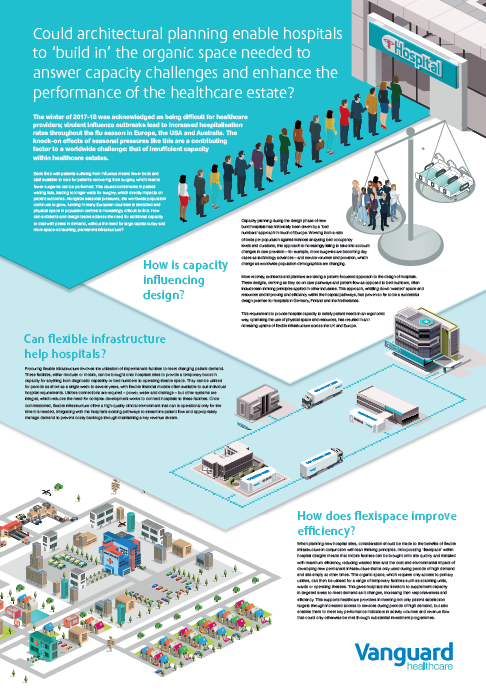Healthcare / Service redesign
European Healthcare Design 2018
Could architectural planning enable hospitals to ‘build in’ the organic space needed to answer capacity challenges and enhance the performance of the healthcare estate?
By Meg Henley, Steven Peak and Dave Clarke | 08 Jun 2018 | 0
There is a growing appetite in the healthcare sector for innovative solutions and the creation of a more flexible infrastructure. This sees a movement away from a problem-led, reactive approach to a focus on building in progressive concepts at the initial design and planning stages. One of the pioneers of this approach is the estates team at Warwick Hospital, South Warwickshire NHS Foundation Trust.
Abstract
Could architectural planning enable hospitals to ‘build in’ the organic space needed to answer capacity challenges and enhance the performance of the healthcare estate?
Healthcare estates departments across the globe face an ongoing challenge to balance increasing patient demand with limited budgets. There is a growing appetite in the healthcare sector for innovative solutions and the creation of a more flexible infrastructure. This sees a movement away from a problem-led, reactive approach to a focus on building in progressive concepts at the initial design and planning stages. One of the pioneers of this approach is the estates team at Warwick Hospital, South Warwickshire NHS Foundation Trust. They’ve taken an innovative approach to planning and design, which works within estates logistical limitations and budget restrictions. One effective model to deliver a longer-term solution to capacity challenges is the ‘plug-and-play’ concept.
Method: Following a successful previous project, Warwick Hospital commissioned a temporary mobile theatre in 2014 as part of the site’s new plug-and-play design concept. Looking for a more innovative but long-term solution to ongoing capacity challenges, the estates department at Warwick Hospital replaced and upgraded a former temporary corridor with a superior weather-resistant build, designed to withstand the cold weather and damp. This substantial corridor formed a connection point, which could accommodate ‘add on’ mobile healthcare facilities brought on site swiftly, as and when required, to meet capacity challenges, such as winter pressures or refurbishment downtime.
From 2014 to the present, the hospital commissioned the installation of a number of mobile health units to form part of this plug-and-play design. A mobile laminar flow theatre, for example, has been incorporated along the patient corridor to deal with reduced capacity and manage patient waiting lists in orthopaedics and general surgery.
Plug-and-play designs have flexibility at their heart, and ‘stand down’ periods are a common feature. With the Warwick Hospital model, for example, the mobile facilities are not used during the school holidays to manage periods of clinical staff unavailability, but services can be swiftly recommissioned when needed.
Outcomes: These include:
- 782 orthopaedic and general surgery procedures performed safely over a staggered six-month period from 2014 to 2016;
- 505 predominantly orthopaedic procedures performed over a 10-month period to date – an average of four per list;
- commissioning mobile health units meant that above-average patient lists were managed during this time.
Implications: The plug-and-play design concept provides a new model of healthcare infrastructure to be considered by architectural designers, estates managers, project leads, and clinical leaders in Europe and internationally.
The flexible approach to opening and shutdown periods, as well as the ability to bring on additional capacity only as and when needed, could play an invaluable and increasing role in the international push for sustainability across the healthcare design sector.
Pre-planning for environmental and seasonal factors that can affect patient flow in hospital settings has huge potential cost savings for healthcare estates and offers financial benefits over an ad-hoc approach to traditional capacity solution.
Organisations involved


